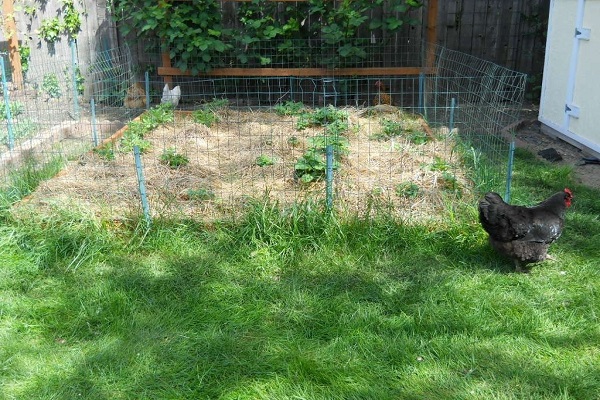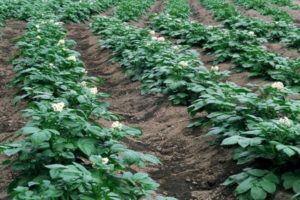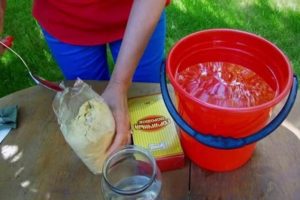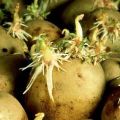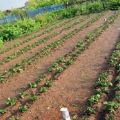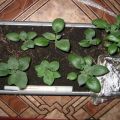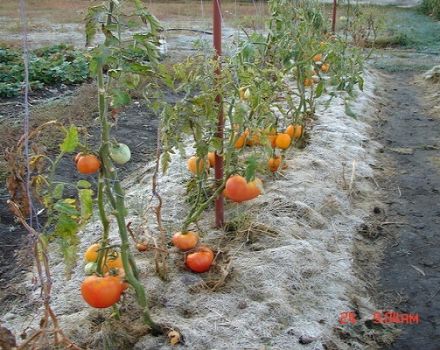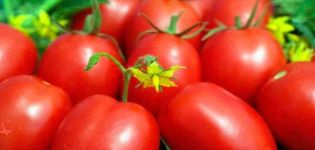Step-by-step description of the method of growing potatoes under hay or straw
It is difficult to harvest a rich potato crop if the area of the plot is small and there is no time to take care of the vegetable. Growers are proposing new planting methods for the popular crop - growing potatoes under straw. You can replace straw with hay, while getting healthy, high-quality tubers in autumn and in large quantities. Moreover, a little space for planting a vegetable is needed.
Method advantages
Instead of the traditional method, potatoes are grown under hay, straw, in bags, pots. But preference is given to growing potatoes under straw or hay, since this method:
- Eco-friendly. After all, there are no chemicals in straw, it is a pure natural material.
- Plain. The planting of seed tubers is easy, the vegetable does not require difficult care, and the potatoes are dug out without effort and effort.
- Helps potato growth. A layer of straw or hay keeps moisture around the developing nodules longer. And plant pests cannot get inside the mulch layer.
- Easy to care for and harvest potatoes. In the fall, you will not need to dig up the tubers by pushing your back. It is enough to rake out a pile of straw or hay to get the potatoes under the straw. And it is not necessary to loosen the planting of the vegetable, to huddle during the whole season.
- Gives a high yield of tubers. It's easy to get a whole bucket of selected potatoes from a bush. And when growing high-quality potatoes and more buckets are harvested from one plant.
But in order for the cultivation method to be successful, you must have knowledge of how to plant seed material correctly, in what time frame.
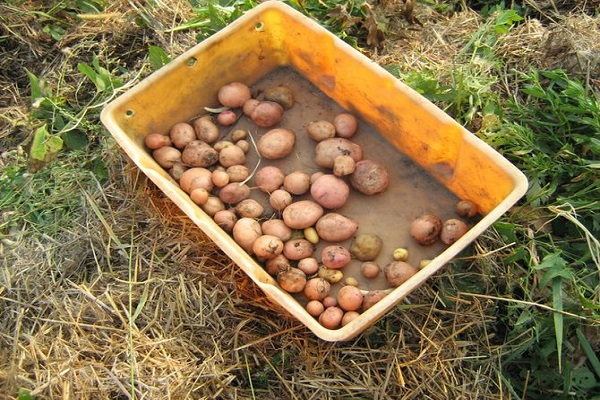
How to grow potatoes under straw or hay?
There are several ways to grow potato tubers under a layer of straw or dry grass.
The classic version is used most often. They begin to prepare for planting a vegetable in the fall, immediately after harvesting. A plot for a vegetable crop is dug up, cleaned of plant residues, debris. It is important to get rid of weedy perennial grasses that can crush potatoes with their powerful rhizomes.
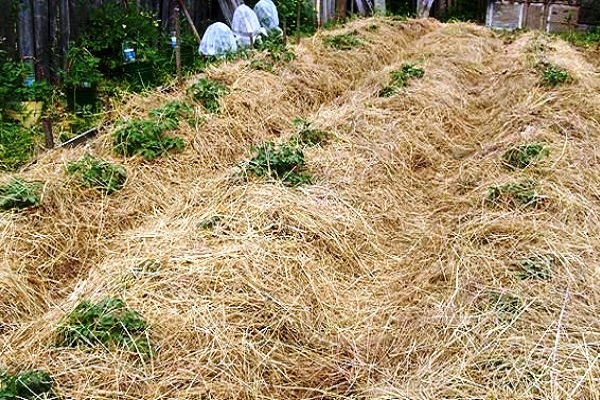
It is better to choose a virgin land for potatoes or one where rye, oats, mustard grew... The roots of mustard, remaining and rotted in the ground, will fertilize the soil well, will not allow the top layer of the soil to erode. Especially in the second half of summer, green manures are planted on the site for potatoes: mustard, oats, in order to mow them in the fall. In the spring, it remains to dig up the fertilized area and that's it.
Potato tubers prepare in advance for landing. For a month, the roots are laid out in boxes for vernalization.A container with seed is placed in rooms where the air temperature will reach no more than fifteen degrees Celsius and not fall below ten.
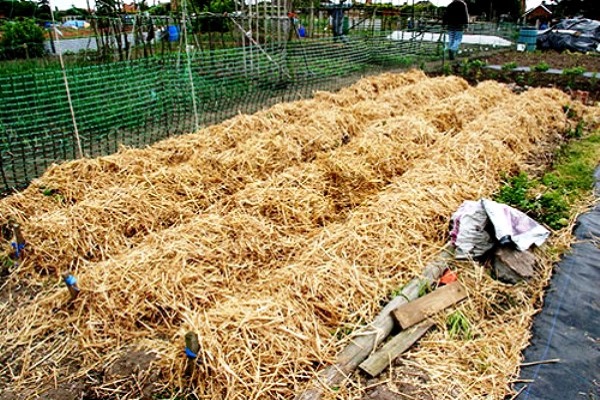
The method of wet vernalization is also used for two weeks. Wet sawdust or humus is added to the boxes with fruits, pouring them over the tubers. The environment around the potatoes is moistened not with clean water, but with the addition of superphosphate (thirty grams) and potassium salt (twenty grams). Fertilizers are dissolved in a bucket of water.
Tubers with sprouts are kept in the light until they turn green. The optimum sprout length is three to five centimeters. With greater growth, they will have to be broken off to the desired length before planting.
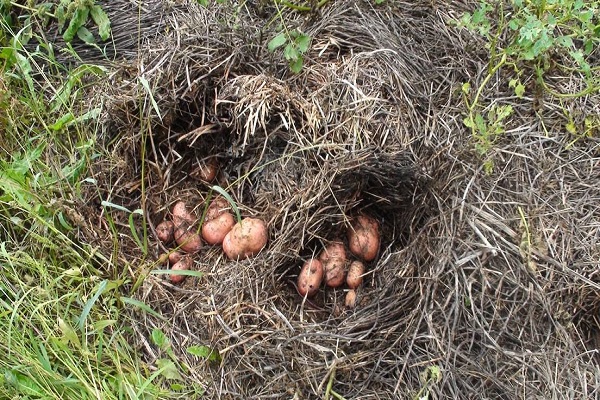
Many people wonder whether it is better to use hay or straw. Experienced potato growers choose dry straw material. It will provide reliable protection for seed tubers and give them nutrition. Hay is also used in potato growing, but freshly cut grass is not suitable for growing vegetables. You can use the same straw for several years in a row, placing it for the winter in a dry and ventilated room for storage.
How to plant potatoes under hay or straw step by step
Planting potatoes under the straw begins, as usual, in May. The exact timing depends on the weather and climate. We plant it no later than May 15, otherwise the tubers will not have time to reach the optimal mass and quality during the growing season.
Step-by-step landing is as follows:
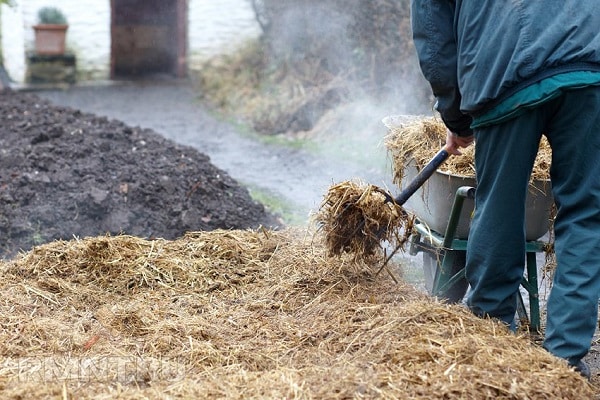
- Water the cleaned bed, moisturizing the soil well.
- Tubers with sprouts are laid out in rows on the surface. At the same time, the sprouts look up. The distance between the tubers should be thirty to forty centimeters. The rows are spaced away from each other - seventy centimeters.
- Pour a glass of wood ash around the tubers.
- It remains to place a layer of twenty to thirty centimeters of hay or straw on the planted potatoes.
Some summer residents use straw as mulch. The seed is buried, as in the traditional technique, placing two tubers in each hole. Sprinkle with a thin layer of earth, and spread straw or hay on top of the field. Potatoes under the straw will feel protected from pests. She has enough moisture and nutrition throughout the growing season.
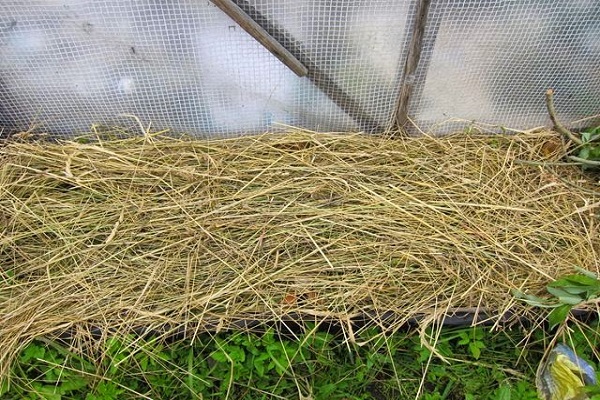
If dry grass is not enough to cover the whole garden with it, then the potatoes are placed under the hay with ridges. Each comb will be twenty centimeters wide and ten centimeters high. This is one of the methods when, even after heavy rains, the tubers will not appear on the surface and will not turn green.
Growing in cardboard and straw
Potatoes can be placed not only under natural material, but also under cardboard. To do this, they take boxes, lay them in a selected area overlapping each other. At a distance of twenty to thirty centimeters, slits are made in the cardboard. Then the sprouted tubers are placed in the holes, sprouts up. A layer of straw or dry grass is poured on top. Potatoes under hay and cardboard will be reliably protected from the Colorado potato beetle. And the weeds will not be able to break into the light and will die.
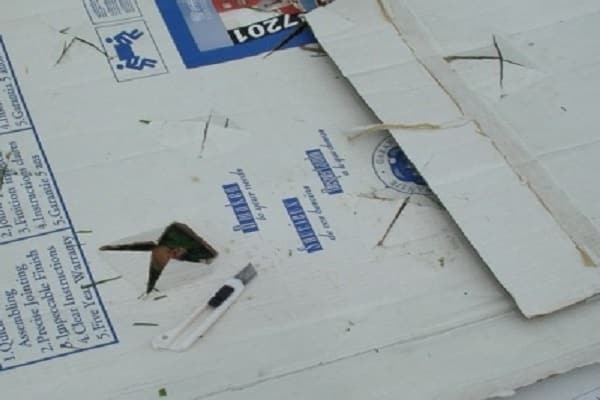
Potato yield increases when using this method. It will be real to get a bucket of healthy tubers from a bush in the fall.
A feature of the methods is that the care of the vegetable is minimal. It is only necessary to add natural material to where the tubers are slightly exposed.
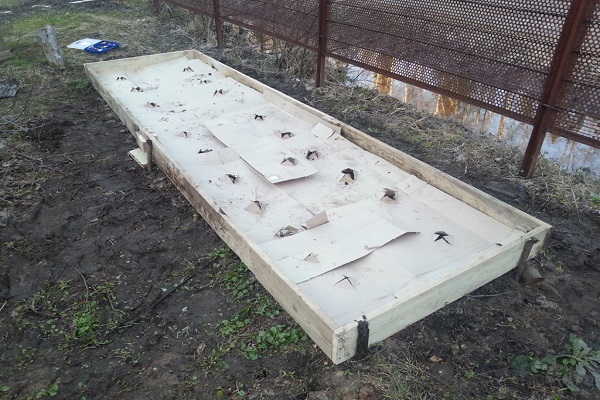
Harvesting potatoes, storing tubers
When potatoes are grown in this unconventional way, it is a pleasure to harvest the tubers.
A layer of straw is raked with a rake, and clean tubers are placed in bags or buckets. If the roots are wet, then they are laid out under an awning. You cannot keep potatoes in the light for a long time, otherwise it will turn green.
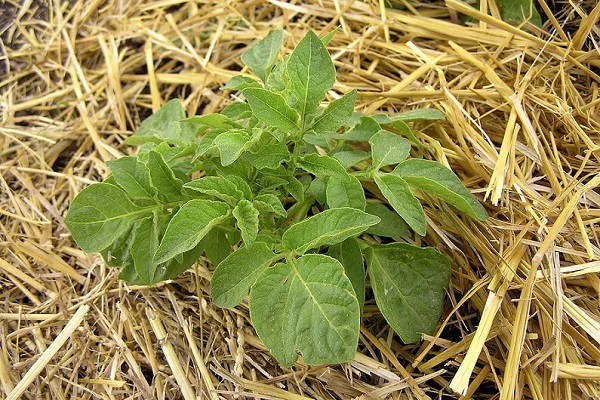
To use potato tubers for food until spring, they must be properly stored:
- The room for potatoes should be dark, with constant ventilation.
- The air temperature in the cellar or basement is controlled. Its stable indicator is three to five degrees above zero. Increasing it will lead to flabbiness of the fruit, the appearance of sprouts. At low temperatures, the potatoes will freeze and their taste will deteriorate.
- The floor of the storage is covered with sand, which absorbs moisture well. It is not recommended to cover it with linoleum, slate. These materials help moisture build up in the room. Hence the appearance and growth of fungus, mold, which can spread to the tubers.
- Potatoes are poured into wooden boxes. Plastic containers are also suitable. It is important that the containers have holes for ventilation of the root crops. Boxes made of iron mesh can save the potato crop from rodents.
- Beets or apples are stored along with potatoes. Beets will not allow moisture to accumulate, apples - to germinate tubers.
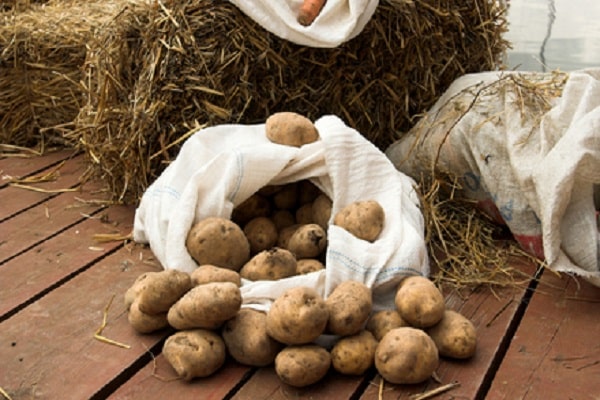
It is not difficult to place potatoes under the straw and grow them, it is more difficult to preserve the harvest, to provide yourself and your family with "second bread" for the winter.
Gardeners' opinion on the method of growing potatoes
Not everyone dares to experiment during the period of growing vegetables. It is difficult to deviate from traditions, but reviews of this method and its high yields lead to the fact that he found his fans. Planting potatoes for hay was chosen by those who do not have the opportunity to deal with the laborious process of caring for the plant.
Hilling and weeding are especially difficult for elderly summer residents. By placing the seed tubers under the dry stems of straw or grass, you can forget about the hassle of gardening before harvesting. The mass of tubers harvested in the fall, their purity and healthy appearance are also striking. And you don't have to work on digging up potatoes. It is convenient to collect tubers from under the straw. You just need to correctly place the vegetable for storage and enjoy the fruits of your labors during the winter.
